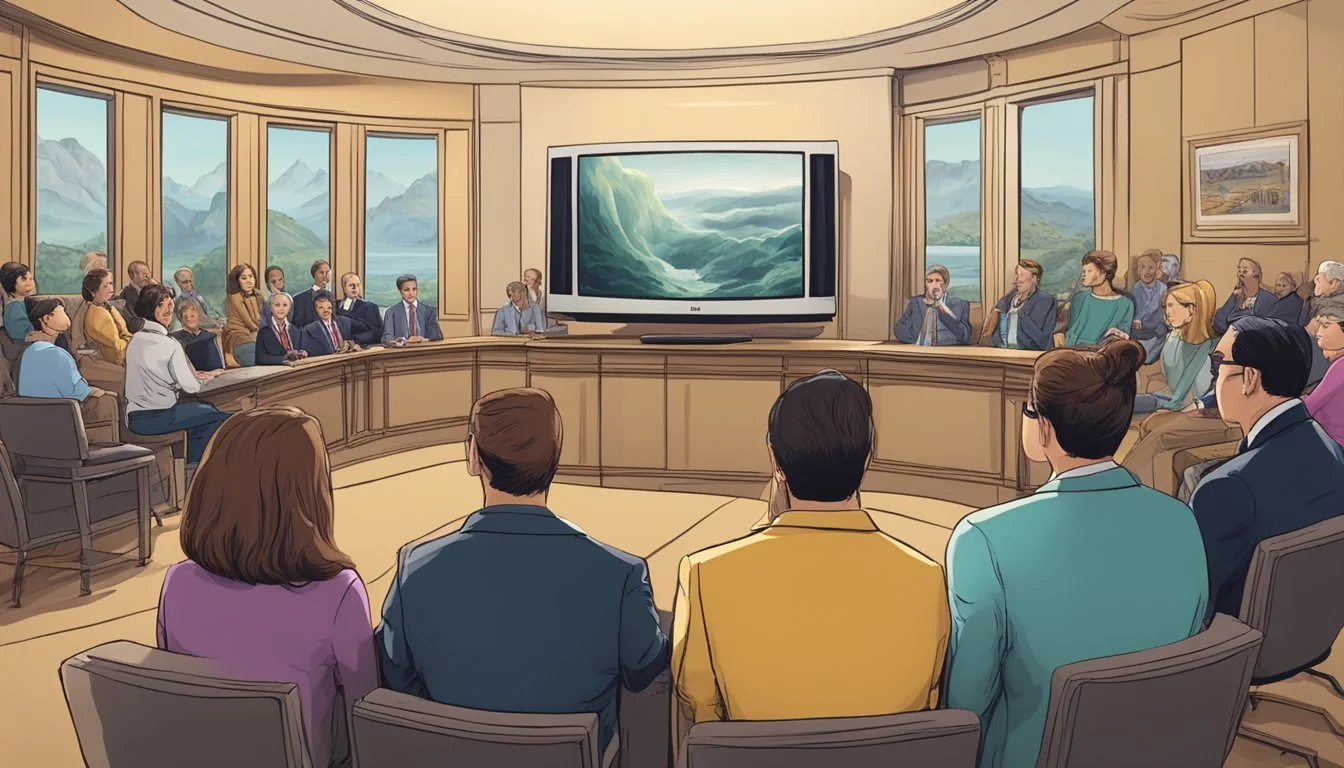Unmasking Scientology: The Real Story Behind Going Clear
Exposing the Controversial Religion's Secrets
"Going Clear: Scientology and the Prison of Belief" is a groundbreaking documentary that peels back the layers of one of the most controversial religious organizations in modern history. Directed by Alex Gibney and based on Lawrence Wright's book of the same name, the film offers an unprecedented look into the inner workings of the Church of Scientology.
The documentary exposes shocking allegations of abuse, manipulation, and exploitation within the organization through interviews with former high-ranking Scientology officials. These firsthand accounts provide viewers with a rare glimpse into the secretive world of Scientology and its impact on members' lives.
Critics have praised "Going Clear" for its thorough research and compelling narrative. The film's exploration of Scientology's origins, practices, and controversies has sparked intense debate and renewed scrutiny of the organization. As a result, "Going Clear" has become essential viewing for those seeking to understand the complex and often troubling reality behind Scientology's public facade.
Origins of Scientology
Scientology emerged in the mid-20th century, founded by L. Ron Hubbard. It began as a self-help system before evolving into a controversial religious movement.
L. Ron Hubbard: The Founder
L. Ron Hubbard, born in 1911, was a prolific science fiction writer before establishing Scientology. He served in the U.S. Navy during World War II and claimed to have healed himself of war injuries using mental techniques.
Hubbard's experiences allegedly inspired his development of Dianetics. He positioned himself as a researcher and philosopher, publishing "Dianetics: The Modern Science of Mental Health" in 1950.
The book became a bestseller, propelling Hubbard into the spotlight. Critics questioned his credentials and methods, but followers embraced his ideas eagerly.
Roots in Dianetics
Dianetics, Hubbard's precursor to Scientology, proposed a method for clearing the mind of negative experiences. It introduced concepts like the "reactive mind" and "engrams," which Hubbard claimed were sources of mental and physical problems.
Dianetics sessions, called "auditing," involved recalling past traumas to eliminate their influence. Practitioners used an "E-meter" device to measure emotional responses during these sessions.
The popularity of Dianetics led to the formation of the Hubbard Dianetic Research Foundation in 1950. However, the organization faced financial and legal challenges, prompting Hubbard to restructure his ideas.
Early Growth and Development
Hubbard incorporated the Church of Scientology in 1953, transforming his self-help system into a religion. This move provided tax benefits and legal protections.
Scientology expanded rapidly, opening churches in major cities across the United States and abroad. The organization developed a hierarchical structure with levels of spiritual advancement.
Hubbard introduced the concept of "thetans," immortal spiritual beings inhabiting human bodies. This idea became central to Scientology's cosmology and practices.
The church faced increasing scrutiny and controversy as it grew. Critics accused it of being a cult, while supporters praised its purported benefits.
Beliefs and Practices
Scientology's belief system revolves around key concepts and practices that form the foundation of the religion. These include the idea of thetans, the process of auditing, and the progression through Operating Thetan levels.
The Thetans Concept
Scientology teaches that humans are immortal spiritual beings called thetans. Thetans are believed to have lived countless past lives and inhabited extraterrestrial civilizations before Earth. According to Scientology doctrine, thetans became trapped in physical bodies, forgetting their true nature and powers.
The goal of Scientology is to "clear" thetans of negative mental impressions called engrams. These engrams are thought to accumulate over many lifetimes and hinder a person's abilities. By addressing engrams, Scientologists aim to restore thetans to their original state of spiritual awareness and capability.
Auditing Process
Auditing is a central practice in Scientology used to identify and resolve engrams. It involves a trained auditor asking specific questions while the subject holds two metal cans connected to an E-meter device. The E-meter purportedly measures electrical resistance in the body, indicating emotional reactions to questions.
During auditing sessions, individuals recount past experiences and traumas. The auditor guides them through this process, aiming to locate and neutralize engrams. Scientologists believe auditing can alleviate physical and mental ailments, boost intelligence, and unlock hidden abilities.
Auditing is typically conducted in a series of paid sessions. Critics argue this system can lead to financial exploitation of members seeking spiritual progress.
Operating Thetan Levels
Scientology offers a structured path of spiritual advancement called the Bridge to Total Freedom. This progression is divided into Operating Thetan (OT) levels, each promising greater spiritual abilities and knowledge.
There are eight OT levels, with OT III being particularly significant. At this level, members learn about Xenu, an alien ruler who allegedly brought billions of people to Earth 75 million years ago and killed them with hydrogen bombs.
Higher OT levels are said to grant abilities like telepathy and out-of-body experiences. However, these claims lack scientific evidence. The content of upper OT levels is kept strictly confidential, accessible only to members who have completed lower levels and paid substantial fees.
Organization and Leadership
Scientology operates through a complex hierarchical structure with distinct leadership roles. The organization has evolved significantly since its founding by L. Ron Hubbard, with notable changes in power dynamics and key figures at the helm.
Church Hierarchy
Scientology's organizational structure resembles a pyramid. At the bottom are new members and staff, while higher levels consist of more advanced practitioners and executives. The Sea Organization, an elite group of dedicated members, plays a crucial role in church operations.
Key positions include:
Chairman of the Board: Highest-ranking official
Executive Director International: Oversees global church activities
Captain of the Sea Org: Leads the most dedicated members
Members progress through various levels, including "Clear" and "Operating Thetan" states, which correspond to increased responsibilities within the church.
Succession After Hubbard
L. Ron Hubbard led Scientology until his death in 1986. In the years leading up to his passing, he gradually withdrew from public view, leaving a power vacuum at the top of the organization.
David Miscavige, a young and ambitious member, emerged as Hubbard's successor. He had worked closely with Hubbard and positioned himself strategically within the church's ranks.
Miscavige's ascent was not without controversy. Some high-ranking members challenged his authority, leading to internal conflicts and purges within the organization.
Current Leadership
David Miscavige remains the de facto leader of Scientology, holding the title of Chairman of the Board of the Religious Technology Center. He exerts significant control over all aspects of the church's operations and doctrine.
Miscavige's leadership style is often described as authoritarian. He has been credited with expanding Scientology's real estate holdings and celebrity connections.
Critics allege that under Miscavige's leadership, the church has become more insular and aggressive in dealing with detractors. Former members have reported instances of abuse and financial exploitation within the organization.
Membership and Community
Scientology's membership comprises a diverse group of individuals drawn to its promise of self-improvement and spiritual enlightenment. The organization maintains a complex hierarchical structure with distinct initiation processes and community norms.
Demographics of Followers
Scientology attracts followers from various backgrounds, though exact numbers are disputed. Estimates range from tens of thousands to millions worldwide. The church claims a higher figure, while critics argue for a much lower count.
Celebrity members have played a significant role in raising the profile of Scientology. Notable figures include actors Tom Cruise and John Travolta.
The organization has a strong presence in urban centers, particularly in the United States. Los Angeles serves as a major hub, housing important Scientology facilities and attracting many aspiring entertainers.
Initiation Rituals
New members typically begin with introductory courses and "auditing" sessions. These involve using an E-meter device to measure electrical resistance, believed to indicate spiritual progress.
As followers advance, they encounter increasingly complex and costly programs. The "Bridge to Total Freedom" outlines a series of levels members must complete.
Higher levels introduce confidential teachings about extraterrestrial influences on human history. These advanced courses can cost tens or hundreds of thousands of dollars.
Life Inside the Community
Dedicated Scientologists often immerse themselves fully in the organization's activities. Some join the Sea Organization, Scientology's elite group requiring a billion-year contract.
Daily life may involve intense study, auditing sessions, and recruitment efforts. Members are encouraged to disconnect from critics, including family members deemed "suppressive persons."
The church provides various services to its community, including education and drug rehabilitation programs. However, these initiatives have faced criticism for their methods and effectiveness.
Controversies and Legal Battles
Scientology has faced numerous controversies and legal challenges since its inception. These range from criminal allegations to disputes over its legal status and high-profile defections.
Criminal Allegations
The Church of Scientology has been accused of various criminal activities. In 1979, eleven high-ranking Scientologists, including L. Ron Hubbard's wife Mary Sue, were convicted of conspiracy against the U.S. government. They had infiltrated federal agencies to purge unfavorable records about Scientology.
In 1986, Scientology faced charges of fraud and tax evasion in Spain. Several members were arrested and the organization's assets were frozen. The case concluded in 2001 with the acquittal of most defendants.
More recently, the Church has been embroiled in allegations of human trafficking and forced labor. Former members claim they were coerced to work long hours for little or no pay in the Sea Org, Scientology's elite corps.
Legal Status and Recognition
Scientology's status as a religion has been hotly contested worldwide. In the United States, the organization gained tax-exempt status in 1993 after a long battle with the IRS. This decision remains controversial, with critics arguing it was obtained through aggressive litigation tactics.
In Germany, Scientology is not recognized as a religion but as a commercial enterprise with political goals. The German government has placed the organization under surveillance due to concerns about its influence.
France classified Scientology as a cult in a 1995 parliamentary report. In 2009, a French court found the Church guilty of fraud, imposing fines but stopping short of banning the group.
Defections and Exposés
High-profile defections have dealt significant blows to Scientology's public image. In 2009, Oscar-winning director Paul Haggis left the Church after 35 years, citing disagreement with its stance on same-sex marriage.
Mike Rinder and Marty Rathbun, former high-ranking Scientology executives, have become vocal critics. They've provided insider accounts of alleged abuses within the organization.
The 2015 documentary "Going Clear" featured testimonies from eight former Scientologists. It shed light on controversial practices such as "disconnection," where members cut ties with family and friends critical of the Church.
These defections and exposés have fueled public scrutiny and led to increased media coverage of Scientology's inner workings.
Media and Public Scrutiny
Scientology has faced intense examination from journalists, filmmakers, and popular culture. This scrutiny has shed light on the organization's practices and beliefs, sparking public debate and controversy.
The Role of Journalism
Investigative reporters have played a crucial role in exposing Scientology's inner workings. Lawrence Wright's book "Going Clear" provided a comprehensive look at the religion's history and practices. The book drew from extensive interviews with former members and meticulous research.
Journalists have uncovered alleged abuses within the organization, including claims of financial exploitation and mistreatment of members. These reports have often faced strong pushback from Scientology's legal team.
Many news outlets have published exposés on Scientology, contributing to public awareness and skepticism about the group's activities.
Depiction in Pop Culture
Television shows and movies have frequently portrayed Scientology, often in a satirical or critical light. South Park's "Trapped in the Closet" episode famously mocked Scientology beliefs, drawing both praise and controversy.
Films like "The Master" have explored themes reminiscent of Scientology's origins, though not explicitly naming the organization. These portrayals have increased public curiosity about the religion.
Celebrity members of Scientology, such as Tom Cruise and John Travolta, have become focal points for media coverage, further amplifying public interest in the organization.
'Going Clear' Documentary Analysis
Alex Gibney's documentary "Going Clear" brought the criticisms of Scientology to a wider audience. The film premiered at the 2015 Sundance Film Festival and later aired on HBO, reaching millions of viewers.
The documentary featured interviews with former high-ranking Scientology officials, providing insider perspectives on the organization's practices. It explored controversial aspects of Scientology, including its tax-exempt status and alleged abuses of members.
"Going Clear" received critical acclaim and several Emmy nominations. The film's impact extended beyond awards, reigniting public discussions about religious freedom and the nature of belief systems.
Insider Accounts and External Perspectives
Former Scientology members, religious scholars, and cult experts provide unique insights into the organization's inner workings and beliefs. Their perspectives shed light on Scientology's practices, doctrines, and impact on individuals.
Testimonies from Former Members
Paul Haggis, an Oscar-winning screenwriter, left Scientology after 35 years. He cited the church's support for Proposition 8, which banned same-sex marriage in California, as a key reason for his departure.
Other ex-members have reported experiences of isolation, financial exploitation, and psychological manipulation. Some describe being pressured to disconnect from family members labeled as "suppressive persons."
Former high-ranking officials like Mike Rinder and Marty Rathbun have provided detailed accounts of Scientology's management structure and alleged abuses of power within the organization.
Critiques from Religious Scholars
Religious scholars have analyzed Scientology's beliefs and practices from an academic perspective. Many question its status as a religion, pointing to its focus on self-improvement techniques and its commercial aspects.
Some scholars compare Scientology's cosmology to science fiction narratives, noting similarities to L. Ron Hubbard's earlier writings. Critics argue that Scientology's teachings lack the depth and historical context of traditional religions.
Researchers have also examined Scientology's aggressive legal tactics against critics and its efforts to gain tax-exempt status in various countries.
Analysis by Cult Experts
Cult experts often classify Scientology as a high-control group or destructive cult. They point to its use of thought reform techniques, such as love bombing and information control.
Steven Hassan, a leading cult expert, has applied his BITE model (Behavior, Information, Thought, and Emotional control) to analyze Scientology's practices. He identifies numerous parallels with other groups considered cults.
Experts highlight the potential psychological harm caused by Scientology's auditing process and its rejection of mainstream mental health treatments. They warn of the difficulties many ex-members face in reintegrating into society after leaving the organization.
Scientology in the Digital Age
The Church of Scientology has embraced modern technology to expand its reach and influence. This shift has led to new challenges and opportunities for the organization in the digital landscape.
Internet and Social Media Presence
Scientology maintains an active online presence through official websites and social media accounts. The church uses platforms like Facebook, Twitter, and YouTube to share promotional content and reach potential converts.
Their official website, scientology.org, offers information on beliefs, practices, and community activities. The organization also operates streaming services like Scientology Network, providing 24/7 access to Scientology-produced content.
Despite these efforts, the church faces significant criticism and negative press online. Many former members use social media to share their experiences and expose alleged abuses within the organization.
Adapting to Modern Technology
Scientology has digitized many of its practices and teachings. E-meters, essential tools in Scientology auditing sessions, now come in electronic versions. The church offers online courses and virtual study materials for members.
Mobile apps like "Volunteer Ministers" allow Scientologists to coordinate humanitarian efforts. The organization has also developed software for managing its vast network of churches and missions worldwide.
However, the church's embrace of technology has been selective. It maintains strict control over the dissemination of its core teachings, with many advanced materials still only available in physical form at official locations.
Online Activism Against Scientology
The internet has become a powerful tool for critics and former members to challenge Scientology's practices. Anonymous, a decentralized online activist group, launched "Project Chanology" in 2008, targeting the church with protests and cyber attacks.
Websites like xenu.net and forums on Reddit provide platforms for sharing critical information about Scientology. These online communities have played a crucial role in exposing alleged abuses and supporting those leaving the church.
The church has responded to online criticism with aggressive legal tactics and reputation management strategies. It has been accused of attempting to manipulate search results and silence critics through copyright claims and intimidation.
Global Impact and Future Outlook
Scientology's influence extends far beyond its origins, shaping its trajectory in the global landscape. The organization faces both opportunities and challenges as it navigates an increasingly interconnected world.
Expansion and International Influence
Scientology has established a presence in numerous countries, with centers and missions spanning six continents. The Church claims over 11,000 facilities worldwide, including churches, missions, and social betterment groups. Major hubs exist in the United States, United Kingdom, Australia, and several European nations.
The organization's expansion efforts focus on acquiring and renovating high-profile properties in major cities. These "Ideal Orgs" serve as prominent outreach centers, aiming to attract new members and boost Scientology's public image.
Scientology's international growth has met resistance in some regions. Germany classifies it as an unconstitutional sect, while Russia has banned Scientology materials as extremist literature.
Challenges and Predictions
Scientology faces significant hurdles in maintaining its influence and membership. Negative publicity from documentaries like "Going Clear" and high-profile defections have damaged its reputation. The internet has made critical information about the organization more accessible, challenging its ability to control its narrative.
Declining membership figures, though disputed by the Church, suggest a potential shrinking of Scientology's base. Some experts predict a continued decline in coming years, particularly in Western countries.
Legal challenges persist, with ongoing lawsuits related to labor practices, financial dealings, and alleged abuses. These issues may impact Scientology's operations and public perception.
Scientology's Place in Future Society
As religious landscapes evolve, Scientology's role remains uncertain. The organization continues to promote its social programs, such as drug rehabilitation and disaster relief, to maintain relevance and positive public relations.
Adaptability will be crucial for Scientology's survival. The Church may need to reform certain practices and increase transparency to appeal to younger generations and skeptical populations.
Technology could play a pivotal role in Scientology's future. The organization might leverage digital platforms to reach new audiences while balancing this with its traditional emphasis on in-person auditing and courses.
Scientology's influence on popular culture, particularly in Hollywood, may wane as public scrutiny increases. This shift could affect its ability to attract high-profile supporters and maintain its glamorous image.









